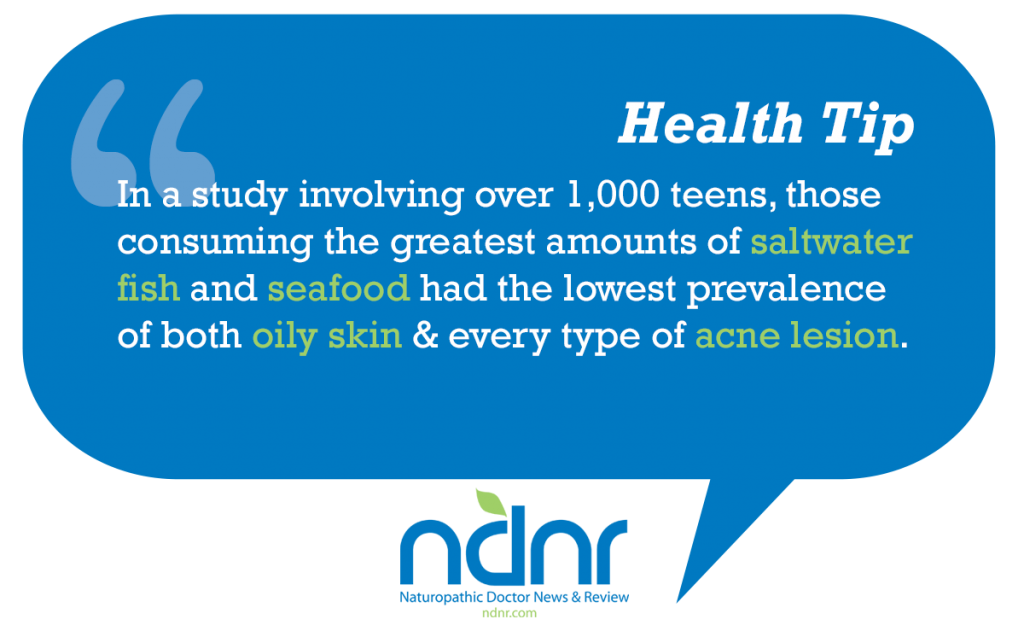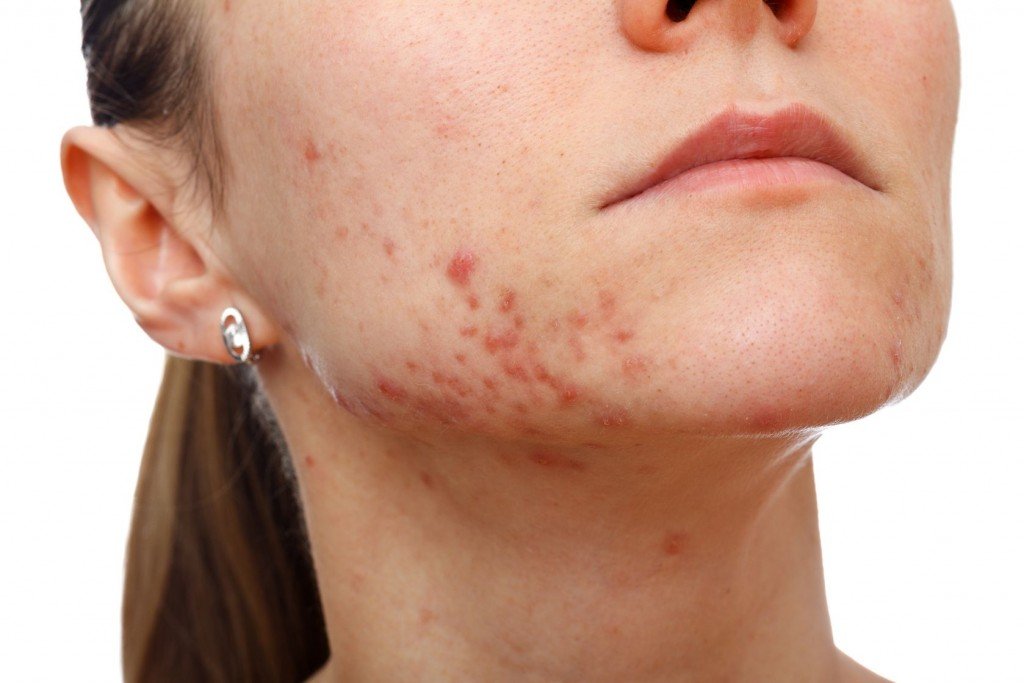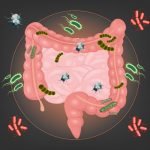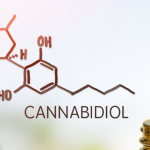Alan C. Logan, ND, FRSH
Introduction
Almost one quarter of all child and teen visits to generalized naturopathic clinics are for skin conditions.1 Rising teen and adult acne rates, now described as a worldwide epidemic, increases the likelihood that naturopathic physicians will encounter acne in the clinical setting.2 Acne is not merely an aesthetic issue; the emotional consequences can subsequently influence how life unfolds. Patients have higher unemployment rates, and are more likely to experience clinical levels of depression and anxiety. The mental health impairment in acne is beyond that of most chronic medical conditions, including epilepsy and diabetes, and thoughts of suicide and suicide rates are higher.3-6 In short, the holistic significance of acne is enormous.
Mechanisms
While the precise mechanisms of the acne process are not understood, the disease is characterized by the overproduction of sebum and follicular hyperkeratinization. Androgens and microbes such as P. acnes play a role in the process.7 More recently the focus has turned to the influence of inflammatory mediators and oxidative stress. The local burden of oxidative stress is such that it can diminish systemic antioxidant levels. Inflammation is now reported to be one of the earliest events, and perhaps the match which lights the candlewick of the acne cascade.8,9
Dietary Dogma
Many patients encountered by naturopathic physicians have previously been told by dermatologists and other medical doctors, or read in popular magazines, that there is no relationship between diet and acne. In order to understand why this belief prevails, a brief discussion of the background research may be worthwhile.
Essentially, 40 years of dietary dogma rests on the shoulders of 2 small studies – notably authored by potentially biased investigators who had previously dismissed any diet-acne relationship.10,11 On the surface the studies indicated that chocolate does not promote acne. Yet, these examinations were so full of research design flaws that it is highly unlikely they would even be considered for publication today. Moving past the small size and limited duration, the lack of any control group in one of the studies, the massive flaw is that neither study recorded or provided instruction on the background diets. In other words, participants could have been eating and drinking literally anything during the evaluation period. The study with a control arm used a look-a-like chocolate bar as a placebo.10 The bars were identical except that the saturated fat from the cacao paste was replaced by several grams of hydrogenated, trans-fat. With no difference in acne provocation between the groups (saturated vs hydrogenated fat chocolate bars), the interpretation was that there is no relationship between chocolate and acne.
Despite the vast limitations, these absurd studies became the seminal work on diet and acne; as years passed by, a myth was born – they became entrenched in dermatological teaching and textbooks. Extrapolation beyond chocolate ensured that generations of dermatologists were instructed that a relationship between acne and any food did not exist.12,13
Such was not always the case. Prior to the pharmaceutical explosion in the 1950s-1960s, dietary influences in the acne process were important components of dermatological teachings. The advice was generally to avoid an excess of simple carbohydrates – especially sugar-rich baked goods, candy, and soft drinks – as well as chocolate, nuts, peanut butter, animal fat, and fried food.14-16 It was also recommended that the intake of milk and milk products be curtailed.14 The diet of choice was one with “plenty of fresh fruit and green vegetables, lean meat, fish and poultry.”16
New Research
Emerging studies over the last 7 years have taken the wrecking ball to the dietary dogma. First, in 2002 researchers reported on the almost complete absence of acne in 2 hunter-gatherer communities – the Kitavans of Papua New Guinea and the Aché of Paraguay. Although tempting to write this off as a genetic anomaly, it was noted that despite sharing similar genetic profiles, members of the same ethnic groups living in relatively close geographic proximity (yet influenced by a Western diet and lifestyle) did experience significant acne. Researchers turned to diet, and although separated by some 10,000 miles, the primary dietary elements of these isolated communities were quite similar – high fiber, high omega-3 intake, a variety of dietary antioxidants, low sugar, low processed foods, and almost no dairy.17
The study of the Kitavans and Aché was strengthened by specific evaluations of acne lesions. The results supported more informal reports of very low rates of acne among the Inuit of the Canadian Northwest Territories, the Okinawa Islands of Japan and other communities where traditional diets had not yet been encroached upon by Western influences.18,19 However, one previous report using careful dermatological evaluations showed that the rates of acne in North America were double that of Japan. These findings from 1964 were simply dismissed as a matter of genetics. In the years since, the acne rates in Japan have risen dramatically, and are now virtually indistinguishable from North America.20,21
Using the principles of healthy dietary advice, Australian researchers initiated much-needed intervention studies. In well-designed, controlled studies, the researchers examined the role of diet on the acne process. In one study the subjects were unaware they were in an acne study per se.22 They were placed on a diet high in fiber, omega-3 fatty acids from fish and seafood, higher in total protein, and low in sugar and saturated fats. Overall the carbohydrates were complex and the totality of the diet was such that it had a low glycemic load. At the conclusion of the 12-week intervention there were significant improvements in acne – an average 22 less acne lesions in those who adhered to the diet.22 These are not only “significant” in the research sense – clinicians and patients alike will certainly consider an average reduction of almost 2 dozen lesions to be clinically relevant. The investigators also reported reduced levels of the acne-promoting androgens in the diet intervention group.22-23
Recently a 1-year online medical survey was reported on acne improvement with the South Beach diet. In over 2200 participants with acne, 87% reported improvement while on a diet low in simple carbohydrates, and rich in only low-glycemic whole grains, fruits vegetables, lean meats and fish. In those with improved skin condition, over 80% reported the benefits had occurred within three months, and of those taking acne medications, 91% either discontinued or lowered medication use.24
Acne-Milk Connection
Three recent studies from Harvard’s School of Public Health have also supported the older dermatological advice to avoid dairy products. The first investigation involved almost 50,000 women, and the second followed 6,000 pre-teen and teen females for 3 years, both finding that milk is strongly associated with acne.25,26 In the third study, over 4,000 teenage boys were followed for 3 years, and once again total milk intake was associated with acne.27 Other forms of dairy such as cheese and sherbets were also implicated, yet fermented yogurt was not – perhaps because yogurt does not have the same insulinogenic properties as milk.28 Microbes may have a beneficial effect and the fermentation also significantly lowers the amount of IGF-1 (insulin-like growth factor 1), the primary hormone within milk that is suspected to promote acne.29,30 Milk may promote acne directly due to the hormones it contains and/or indirectly by spiking blood insulin levels. Elevated insulin may be a driving force in sebum production; therefore, foods that are rich in fiber, such as those consumed in traditional diets, may offer dietary protection.22
The Omega-3 Protective Pathways
In a study involving over 1,000 teens, those consuming the greatest amounts of saltwater fish and seafood had the lowest prevalence of both oily skin and every type of acne lesion.31 Sadly, patients with acne are infrequent consumers of dietary fish and seafood, possibly in part due to the enduring falsehood that iodine causes acne.32,33
There are certainly mechanisms whereby fish oil may be effective in reducing inflammatory acne. The inflammatory chemical leukotriene B4 (LTB4) upregulates sebum production, and conversely, inhibition of LTB4 leads to significant improvement in acne.34,35 Sophisticated studies have demonstrated that each pilosebaceous unit can manufacture inflammatory chemicals, including LTB4 – the raw materials provided by breakdown products of dietary fats.36 Fish oil, and eicosapentaenoic acid (EPA) in particular, is well documented to support its ability to inhibit LTB4 production.37
Oxidative Stress
The influence of oxidative stress is also of clinical relevance. Oxidative stress increases the generation of local inflammatory mediators in the skin and places a burden on the antioxidant defense system.9 Indeed, there is greater oxidative stress with increasing acne severity.38-41 And lower levels of vitamins A and E among 200 age-matched acne patients vs controls was recently found to be associated with the severity of acne.42 The selenium-dependent glutathione peroxidase enzyme activity is low in acne patients, and it has been theorized that selenium would be of value. Indeed, low levels of blood selenium have been documented in acne patients, and a 3-month clinical study reported significant value of selenium (400 mcg) and vitamin E (20 mg) daily.43,44 The epigallocatechin-3-gallate (EGCG) polyphenol from Camellia sinensis has also been suggested to be helpful in acne due to its anti-inflammatory and antioxidant activity. In addition, EGCG may also influence hormonal aspects of acne since it is known to possess 5-α-reductase inhibiting properties, thereby limiting the production of acne-promoting dihydrotestosterone.45 Other botanical remedies which have antioxidant and anti-inflammatory activity, such as Curcuma longa, have a long history of use in skin disorders such as acne.46
Other Nutrients
A number of studies have shown that zinc levels are lower in acne patients, and oral and/or topical combination zinc may be of therapeutic value.47-49 Since insulin and blood sugar abnormalities appear be involved in the promotion of acne, it has been theorized that oral chromium may be helpful, and one preliminary trial showed that 400 mcg of chromium provides clinical benefit.50
Acne, Mental Health and Nutrition
Marine lipids, minerals, and phytochemicals certainly have potential to reduce inflammatory acne lesions, and yet it also seems that these are the same nutrients capable of influencing mental outlook, depressive symptoms, and anxiety. Omega-3 fatty acids, zinc, selenium, chromium, and even phytochemicals such as those found in Camellia sinensis, have been shown to improve mood and decrease anxiety in various studies.51-57 It has been suggested that such supplemented nutrients, or combinations thereof, might influence inflammatory acne and perhaps more importantly, the mental outlook of users with acne.58 While clinical studies are lacking, a series of case reports has indicated supplemental EPA (1000 mg daily) combined with zinc (15 mg), selenium (200 mcg), chromium (200 mcg) and EGCG (200 mg) from Camellia sinensis can improve acne (20+ less lesions on average) and improve mental outlook (24% improvement in global aspects of well-being).59
Tolle Totem – Treat the Whole Person
There are 2 other areas of organ system support for clinical consideration – the liver and the gastrointestinal tract. There have been hints in the literature suggesting that nutritional support of phase II detoxification may be helpful. An older Japanese study found that glucuronic acid, which helps to transform and eliminate hormones, improved acne in 78% of patients.60 In addition, at least 3 studies have shown that orally administered probiotics may be helpful in acne.61-63
Studies show a connection between emotional stress (eg, exam stress and relationship difficulties) and acne provocation.64,65 Naturopathic physicians are aware that nutritional principles should not be viewed in isolation. Research clearly shows that dietary habits change course in an unhealthy direction while under stress, and the value of mind-body medicine interventions should be considered.66
Validation
Writing in the American Family Physician in 1971, one dermatologist commenting on acne and diet stated, “Too many patients harbor the delusion that their health can somehow be mysteriously harmed by something in their diet.”11 Thankfully, naturopathic physicians never wavered from the position that diet matters. The recent advances in acne-diet research have provided validation of naturopathic nutrition, and more importantly, the convictions of acne patients. It has also provided pathways for a therapeutic nutritional bridge between reductions in acne lesions and improved mental outlook in those with acne.
 Alan C. Logan, ND, FRSH is a graduate of CCNM, holds licensure in Connecticut and is an invited faculty member of Harvard’s School of Continuing Medical Education, where he lectures in the mind-body medicine courses. Co-author of The Clear Skin Diet and Your Skin, Younger, his commentaries have appeared in the Archives of Dermatology, the International Journal of Dermatology, the Journal of the American Academy of Dermatology and the British Journal of Dermatology.
Alan C. Logan, ND, FRSH is a graduate of CCNM, holds licensure in Connecticut and is an invited faculty member of Harvard’s School of Continuing Medical Education, where he lectures in the mind-body medicine courses. Co-author of The Clear Skin Diet and Your Skin, Younger, his commentaries have appeared in the Archives of Dermatology, the International Journal of Dermatology, the Journal of the American Academy of Dermatology and the British Journal of Dermatology.
References
- Wilson K, Busse JW, Gilchrist A, Vohra S, Boon H, Mills E. Characteristics of pediatric and adolescent patients attending a naturopathic college clinic in Canada. Pediatrics. 2005;115(3):338-343.
- Silverberg NB, Weinberg JM. Rosacea and adult acne: a worldwide epidemic. Cutis. 2001;68(2):85.
- Loney T, Standage M, Lewis S. Not just ‘skin deep’: psychosocial effects of dermatological-related social anxiety in a sample of acne patients. J Health Psychol. 2008;13(1):47-54.
- Magin P, Adams J, Heading G, Pond D, Smith W. Psychological sequelae of acne vulgaris: results of a qualitative study. Can Fam Physician. 2006;52:978–979.
- Purvis D, Robinson E, Merry S, Watson P. Acne, anxiety, depression and suicide in teenagers: a cross-sectional survey of New Zealand secondary school students. J Paediatr Child Health. 2006;42(12):793-796.
- Mallon E, Newton JN, Klassen A, Stewart-Brown SL, Ryan TJ, Finlay AY. The quality of life in acne: a comparison with general medical conditions using generic questionnaires. Br J Dermatol. 1999;140(4):672-676.
- Thiboutot DM. Overview of acne and its treatment. Cutis. 2008;81(suppl 1):3-7.
- Holland DB, Jeremey AH. The role of inflammation in the pathogenesis of acne and acne scarring. Semin Cutan Med Surg. 2005;24(2):79-83.
- Sarici G, Cinar S, Armutcu F, Altinyazar C, Koca R, Tekin N. Oxidative stress in acne vulgaris. J Eur Acad Dermatol Venereol. 2009 Nov 23. [Epub ahead of print].
- Fulton JE Jr, Plewig G, Kligman AM. Effect of chocolate on acne vulgaris. JAMA. 1969;210(11):2071-2074.
- Anderson PC. Foods as the cause of acne. Am Fam Physician. 1971;3(3):102-103.
- Cunliffe WJ, Simpson NB. Disorders of sebaceous glands. In: Rook A, Wilkinson DS, Ebling FJG, Champion RH, Robert H, eds. Rook/Wilkinson/Ebling Textbook of Dermatology. 6th ed. Oxford, UK: Blackwell Science; 1998:1951.
- Thiboutot DM, Strauss JS. Diseases of the sebaceous glands. In: Freedberg IM, Eisen AZ, Wolff K, et al, eds. Fitzpatrick’s Dermatology in General Medicine. Vol 1. 6th ed. New York, NY: McGraw-Hill; 2003:683.
- Baird JW. Acne; a new approach to an old problem. J Pediatr. 1958;52(2):152-157.
- Stokes JH. Fundamentals of Medical Dermatology. 7th ed. Philadelphia: University of Pennsylvania Department of Dermatology Book Fund; 1942.
- Barber HW. Diseases of the skin: acne vulgaris. In: Poulton EP, ed. Taylor’s Practice of Medicine. 15th ed. London, UK: JA Churchill Ltd; 1936:860-861.
- Cordain L, Lindeberg S, Hurtado M, Hill K, Eaton SB, Brand-Miller J. Acne vulgaris: a disease of Western civilization. Arch Dermatol. 2002;138(12):1584-1590.
- Bendiner E. Disastrous trade-off: Eskimo health for white civilization. Hosp Pract. 1974;9:156-189.
- Schaefer O. When the Eskimo comes to town. Nutr Today. 1971;6(6):8-16.
- Hamilton JB, Terada H, Mestler GE. Greater tendency to acne in white American than in Japanese populations. J Clin Endocrinol Metab. 1964;24:267-272.
- Hayashi N, Kawashima M, Watanabe S, et al. An epidemiological study of acne vulgaris in Japan by questionnaire. Jpn J Dermatol. 2001;111(9):1347-1355.
- Smith RN, Mann NJ, Braue A, Mäkeläinen H, Varigos GA. The effect of a high-protein, low glycemic-load diet versus a conventional, high glycemic-load diet on biochemical parameters associated with acne vulgaris: a randomized, investigator-masked, controlled trial. J Am Acad Dermatol. 2007;57(2):247-256.
- Smith R, Mann N, Mäkeläinen H, Roper J, Braue A, Varigos G. A pilot study to determine the short-term effects of a low glycemic load diet on hormonal markers of acne: a nonrandomized, parallel, controlled feeding trial. Mol Nutr Food Res. 2008;52(6):718-726.
- Rouhani P, Berman B, Rouhani G. Acne improves with a popular, low glycemic diet from South Beach. Poster presented at: American Academy of Dermatology 67th Annual Meeting; March 6–10, 2009; San Francisco, California.
- Adebamowo CA, Spiegelman D, Berkey CS, et al. Milk consumption and acne in adolescent girls. Dermatol Online J. 2006;12(4):1.
- Adebamowo CA, Spiegelman D, Danby FW, Frazier AL, Willett WC, Holmes MD. High school dietary dairy intake and teenage acne. J Am Acad Dermatol. 2005;52(2):207-214.
- Adebamowo CA, Spiegelman D, Berkey CS, et al. Milk consumption and acne in teenaged boys. J Am Acad Dermatol. 2008;58(5):787-793.
- Ostman EM, Liljeberg Elmståhl HG, Björck IM. Inconsistency between glycemic and insulinemic responses to regular and fermented milk products. Am J Clin Nutr. 2001;74(1):96-100.
- Kang SH, Kim JU, Imm JY, Oh S, Kim SH. The effects of dairy processes and storage on insulin-like growth factor-I (IGF-I) content in milk and in model IGF-I-fortified dairy products. J Dairy Sci. 2006;89(2):402-409.
- Melnik B. Milk consumption: aggravating factor of acne and promoter of chronic diseases of Western societies [in English, German]. J Dtsch Dermatol Ges. 2009;7(4):364-370.
- Hitch JM, Greenburg BG. Adolescent acne and dietary iodine. Arch Dermatol. 1961;84:898-911.
- Labadarios D, Cilliers J, Visser L, et al. Vitamin A in acne vulgaris. Clin Exp Dermatol. 1987;12(6):432-436.
- Danby FW. Acne and iodine: reply. J Am Acad Dermatol. 2007;56(1):164-165.
- Zouboulis CC, Nestoris S, Adler YD, et al. A new concept for acne therapy: a pilot study with zileuton, an oral 5-lipoxygenase inhibitor. Arch Dermatol. 2003;139(5):668-670.
- Zouboulis ChC, Saborowski A, Boschnakow A. Zileuton, an oral 5-lipoxygenase inhibitor, directly reduces sebum production. Dermatology. 2005;210(1):36-38.
- Alestas T, Ganceviciene R, Fimmel S, Müller-Decker K, Zouboulis CC. Enzymes involved in the biosynthesis of leukotriene B4 and prostaglandin E2 are active in sebaceous glands. J Mol Med. 2006;84(1):75-87.
- James MJ, Gibson RA, Cleland LG. Dietary polyunsaturated fatty acids and inflammatory mediator production. Am J Clin Nutr. 2000;71(1 suppl):343S-348S.
- Arican O, Kurutas EB, Sasmaz S. Oxidative stress in patients with acne vulgaris. Mediators Inflamm. 2005(6):380-384.
- Basak PY, Gultekin F, Kilinc I. The role of the antioxidative defense system in papulopustular acne. J Dermatol. 2001;28(3):123-127.
- Briganti S, Picardo M. Antioxidant activity, lipid peroxidation and skin diseases. What’s new. J Eur Acad Dermatol Venereol. 2003;17(6):663-669.
- Abdel Fattah NS, Shaheen MA, Ebrahim AA, El Okda ES. Tissue and blood superoxide dismutase activities and malondialdehyde levels in different clinical severities of acne vulgaris. Br J Dermatol. 2008;159(5):1086-1091.
- El-Akawi Z, Abdel-Latif N, Abdul-Razzak K. Does the plasma level of vitamins A and E affect acne condition? Clin Exp Dermatol. 2006;31(3):430-434.
- Michaëlsson G, Edqvist LE. Erythrocyte glutathione peroxidase activity in acne vulgaris and the effect of selenium and vitamin E treatment. Acta Derm Venereol. 1984;64(1):9-14.
- Michaelsson G. Decreased concentration of selenium in whole blood and plasma in acne vulgaris. Acta Derm Venereol. 1990;70(1):92.
- Shaw JC. Green tea polyphenols may be useful in the treatment of androgen-mediated skin disorders. Arch Dermatol. 2001;137(5):664.
- Jain A, Basal E. Inhibition of Propionibacterium acnes-induced mediators of inflammation by Indian herbs. Phytomedicine. 2003;10(1):34-38.
- Dreno B, Amblard P, Agache P, Sirot S, Litoux P. Low doses of zinc gluconate for inflammatory acne. Acta Derm Venereol. 1989;69(6):541-543.
- Dreno B, Foulc P, Reynaud A, Moyse D, Habert H, Richet H. Effect of zinc gluconate on propionibacterium acnes resistance to erythromycin in patients with inflammatory acne: in vitro and in vivo study. Eur J Dermatol. 2005;15(3):152-155.
- Niren NM, Torok HM. The Nicomide Improvement in Clinical Outcomes Study (NICOS): results of an 8-week trial. Cutis. 2006;77(1 suppl):17-28.
- McCarty M. High-chromium yeast for acne? Med Hypotheses. 1984;14(3):307-310.
- Freeman MP, Hibbeln JR, Wisner KL, et al. Omega-3 fatty acids: evidence basis for treatment and future research in psychiatry. J Clin Psychiatry. 2006;67(12):1954-1967.
- Levenson CW. Zinc: the new antidepressant? Nutr Rev. 2006;64(1):39-42.
- Benton D. Selenium intake, mood and other aspects of psychological functioning. Nutr Neurosci. 2002;5(6):363-374.
- Davidson JR, Abraham K, Connor KM, McLeod MN. Effectiveness of chromium in atypical depression: a placebo-controlled trial. Biol Psychiatry. 2003;53(3):261-264.
- Vignes M, Maurice T, Lanté F, et al. Anxiolytic properties of green tea polyphenol (-)-epigallocatechin gallate (EGCG). Brain Res. 2006;1110(1):102-115.
- Dreiseitel A, Korte G, Schreier P, et al. Berry anthocyanins and their aglycons inhibit monoamine oxidases A and B. Pharmacol Res. 2009;59(5):306-311.
- Milesi MA, Lacan D, Brosse H, Desor D, Notin C. Effect of an oral supplementation with a proprietary melon juice concentrate (Extramel) on stress and fatigue in healthy people: a pilot, double-blind, placebo-controlled clinical trial. Nutr J. 2009;8:40.
- Katzman M, Logan AC. Acne vulgaris: nutritional factors may be influencing psychological sequelae. Med Hypotheses. 2007;69(5):1080-1084.
- Rubin MG, Kim K, Logan AC. Acne vulgaris, mental health and omega-3 fatty acids: a report of cases. Lipids Health Dis. 2008;7:36.
- Aikawa A, Mihara J, Tanida T, Tsukada S. The effects of glucuronic acid on acne vulgaris. Tohoku J Exp Med. 1956;64(3-4):301-303.
- Siver RH. Lactobacillus for the control of acne. J Med Soc New J. 1961;58:52-83.
- Marchetti F, Capizzi R, Tulli A. Efficacy of regulators of the intestinal bacterial flora in the therapy of acne vulgaris [in Italian]. Clin Ter. 1987;122(5):339-343.
- Volkova LA, Khalif IL, Kabanova IN. Impact of the impaired intestinal microflora on the course of acne vulgaris [in Russian]. Klin Med (Mosk). 2001;79(6):39-41.
- Chiu A, Chon SY, Kimball AB. The response of skin disease to stress: changes in the severity of acne vulgaris as affected by examination stress. Arch Dermatol. 2003;139(7):897-900.
- Harrington CI. Post-adolescent acne and marital break-up. Br J Dermatol. 1997;137(3):478-479.
- Cartwright M, Wardle J, Steggles N, Simon AE, Croker H, Jarvis MJ. Stress and dietary practices in adolescents. Health Psychol. 2003;22(4):362-369.





